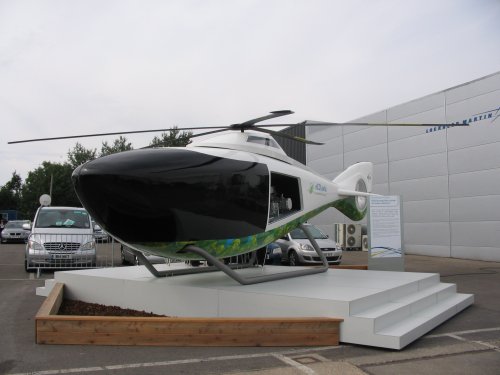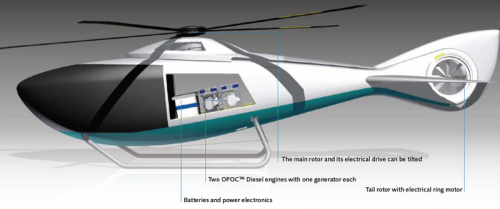- Joined
- 28 January 2008
- Messages
- 631
- Reaction score
- 469
The image below was taken at Farnborough Air Show 2010, located behind the main hall complex. It shows the mock-up of the EADS Eco2Avia Hybrid Helicopter. This was one of the projects that were grouped under the name of eCO2avia by EADS Innovation Works as part of the EADS Group’s research into alternative propulsion and fuels.
Other projects under the Eco2Avia banner included:
• ZEHST (Zero Emission High Supersonic Transport)
• Voltair (see - http://www.secretprojects.co.uk/forum/index.php/topic,13032.msg128866.html#msg128866 )
• E-Fan
• E-Thrust ( see - http://www.secretprojects.co.uk/forum/index.php/topic,8206.msg191787.html#msg191787 )
EADS unveiled a model of a hybrid helicopter concept at the ILA Berlin Airshow on June 8 2010 which, they said, could cut emissions and fuel consumption in half while improving safety margins.
The helicopter concept used four diesel-electric motor generator units, two high performance batteries and a power electronics unit. Known as ‘Opposed piston opposed cylinder’ (OPOC) diesel engines, supplied by EcoMotors International, these would generate electrical power for the main and tail rotors, with their power output shafts coupled to generators delivering electrical current to a power electronics unit. This then managed the distribution of electricity to the electric motors which would then drive the main and tail rotors, to and from the batteries, and to other systems on the helicopter. The EcoMotors engines themselves were 30% more fuel efficient than contemporary turbine engines
Exhaust emissions would be cut by over a half, when compared to a Eurocopter EC-135, by using innovative combustion engines in a hybrid diesel-electric propulsion system with electrical main rotor and tail rotor drives.
The hybrid propulsion system would allow the main rotor and its electrical drive to be tilted forward during the cruise phase and allow the helicopter’s fuselage to remain at its optimum alignment with the airstream, minimising aerodynamic drag and reducing power demand and fuel consumption. The tail rotor had no mechanical linkage to the main rotor and the power could be reduced or turned off at higher speeds as stability, control and the balancing of rotor torque were provided by the aerodynamic properties of the helicopter’s tail fin and rudder.
Takeoff and landing would be possible on the helicopters electrical power alone, resulting in lower noise levels and improved flight safety.
In 2011, EADS had two programs under way: BlueCopter to replace the single turboshaft in its EC120 with a diesel; and eCO2avia hybrid diesel-electric propulsion system. At Farnborough EADS said the next step could be to build a flying prototype. Is this still the aim or is this aesthetically pleasing machine now shelved?
The other images are an EADS diagram of the helicopter and a photo of the engine bay of the mock-up.
Sources:
Australian Aviation Magazine (June 2010)
Flight (Jun/July 2010)
AWST (Mar 2011)
Other projects under the Eco2Avia banner included:
• ZEHST (Zero Emission High Supersonic Transport)
• Voltair (see - http://www.secretprojects.co.uk/forum/index.php/topic,13032.msg128866.html#msg128866 )
• E-Fan
• E-Thrust ( see - http://www.secretprojects.co.uk/forum/index.php/topic,8206.msg191787.html#msg191787 )
EADS unveiled a model of a hybrid helicopter concept at the ILA Berlin Airshow on June 8 2010 which, they said, could cut emissions and fuel consumption in half while improving safety margins.
The helicopter concept used four diesel-electric motor generator units, two high performance batteries and a power electronics unit. Known as ‘Opposed piston opposed cylinder’ (OPOC) diesel engines, supplied by EcoMotors International, these would generate electrical power for the main and tail rotors, with their power output shafts coupled to generators delivering electrical current to a power electronics unit. This then managed the distribution of electricity to the electric motors which would then drive the main and tail rotors, to and from the batteries, and to other systems on the helicopter. The EcoMotors engines themselves were 30% more fuel efficient than contemporary turbine engines
Exhaust emissions would be cut by over a half, when compared to a Eurocopter EC-135, by using innovative combustion engines in a hybrid diesel-electric propulsion system with electrical main rotor and tail rotor drives.
The hybrid propulsion system would allow the main rotor and its electrical drive to be tilted forward during the cruise phase and allow the helicopter’s fuselage to remain at its optimum alignment with the airstream, minimising aerodynamic drag and reducing power demand and fuel consumption. The tail rotor had no mechanical linkage to the main rotor and the power could be reduced or turned off at higher speeds as stability, control and the balancing of rotor torque were provided by the aerodynamic properties of the helicopter’s tail fin and rudder.
Takeoff and landing would be possible on the helicopters electrical power alone, resulting in lower noise levels and improved flight safety.
In 2011, EADS had two programs under way: BlueCopter to replace the single turboshaft in its EC120 with a diesel; and eCO2avia hybrid diesel-electric propulsion system. At Farnborough EADS said the next step could be to build a flying prototype. Is this still the aim or is this aesthetically pleasing machine now shelved?
The other images are an EADS diagram of the helicopter and a photo of the engine bay of the mock-up.
Sources:
Australian Aviation Magazine (June 2010)
Flight (Jun/July 2010)
AWST (Mar 2011)


